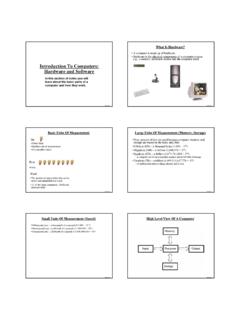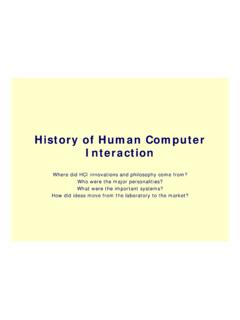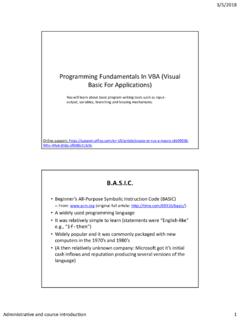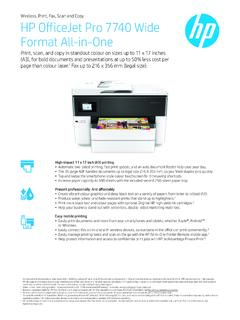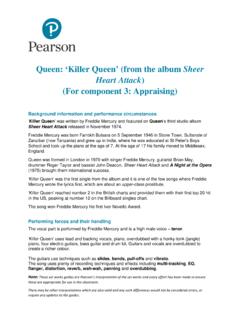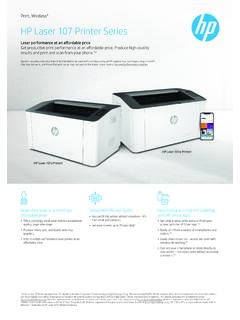Transcription of Introduction To Computers: Hardware and Software
1 Introduction to computers1 James TamIntroduction To Computers: Hardware and SoftwareIn this section of notes you will learn about the basic parts of a computer and how they TamWhat Is Hardware ? A computer is made up of Hardware . Hardware is the physical componentsof a computer system , a monitor, keyboard, mouse and the computer TamBasic Units Of MeasurementBit Binary digit Smallest unit of measurement Two possible valuesByte 8 bitsWord The number of adjacent bits that can be stored and manipulated as a unit 32, 64 for home computers, 128 for the most powerfulJames TamLarge Units Of Measurement (Memory, Storage) Note: powers of two are used because computer memory and storage are based on the basic unit (bit).
2 Kilobyte (kB) a thousand bytes (1,024 = 210) Megabyte (MB) - a million (1,048,576 = 220) Gigabyte (GB) a billion (1,073,741,824 = 230)~ A complete set of encyclopedias requires about 600 MB of storage Terabyte (TB) a trillion (1,099,511,627,776 = 240)~ 20 million four-drawer filing cabinets full of textJames TamSmall Units Of Measurement (Speed) Millisecond (ms) a thousandth of a second (1/1,000 = 10-3) Microsecond ( s) - a millionth of a second (1/1,000,000 = 10-6) Nanosecond (ns) a billionth of a second (1/1,000,000,000 = 10-9)James TamHigh Level View Of A ComputerIntroduction to computers2 James TamBuses Connect the different parts of the computer togetherJames TamBuses (2)Image from Peter Norton's Computing Fundamentals (3rdEdition) by Norton TamPorts Connects the computer to the outsideJames TamPortsJames TamInputJames TamInput Devices Used by a person to communicate to a to computerIntroduction to computers3 James TamExample Input Devices Keyboard Mouse Need not be mundane!
3 From , , Baumback, M., Visual Hand Pose Identification for Intelligent User Interfaces,Vision Interface 2003, Halifax, Nova Scotia, Canada Jun 11-13, 2003 James TamProcessorJames TamProcessor The brains of a computer A common desktop TamProcessor Speed Determined by:- Type of processor , Pentium IV, AMD Athlon, Opteron-Clock speed 1 Hz = 1 pulse is sent out each second (1 second passes between each pulse) 10 Hz = 10 pulses are sent out each second ( seconds passes between each pulse) : 25 MHz = 25 million pulses sent out each second ( 000 04 seconds between each pulse or 40 ns between pulses) Ghz = billion pulses sent out each second ( ns between pulses)James TamThe Processor And The ComputerImage from Peter Norton's Computing Fundamentals (3rdEdition) by Norton TamMemoryIntroduction to computers4 James TamRAM Volatile Used for temporary storage Typical ranges 256 MB - 4 GBJames TamRAM (2) Means direct access to any part of memory The typical form of RAM is DRAM (Dynamic RAM)Picture from Computers in your future by Pfaffenberger B James TamHow Does DRAM Work?
4 Most RAM is DRAM (Dynamic RAM) Acts like a leaky bucketFrom TamHow Does DRAM Work? Most RAM is DRAM (Dynamic RAM) Acts like a leaky bucketFrom TamDRAM: A Collection Of CapacitorsA capacitorJames TamStorageIntroduction to computers5 James TamStorage Vs. Memory?Memory ( , RAM) Keep the information for a shorter period of time (usually volatile) Faster More expensiveStorage ( , Hard disk) The information is retained longer (non-volatile) Slower CheaperJames TamCategories Of Storage1. Magnetic-Floppy disks-Zip disks-Hard drives2. Optical-CD-ROM-DVDJ ames TamMagnetic DrivesPictures from TamMagnetic Drives: Storage Capacities Floppy disks-~ 1 MB Zip disks- 100, 250, 750 MB Hard drives- ~80 300 GBJames TamOptical Drives: Reading InformationJames TamOptical Drives: Recording and Reading InformationIntroduction to computers6 James TamOptical Drives: Re-Writing James TamOptical Drives: Re-Writing James TamOptical Drives CD's- ~ 700 MB storage- CD-ROM (read only) -CD-R: (record) to a CD- CD-RW: can write and erase CD to reuse it (re-writable) DVD-ROM- Over 4 GB storage (varies with format)- DVD- ROM (read only)- Many recordable formats ( , DVD-R, CD-RW.)
5 DVD+R, DVD+RW)James TamOutputJames TamOutput Devices Displays information from the computer to the a TamThe Most Common Output Device: The MonitorTypes of computer monitors1) CRT's (Cathode Ray Tube)2) LCD's (Liquid Crystal Display) Introduction to computers7 James TamCRT's Monitors Images are displayed with dots (pixels) drawn with light "guns"Picture from computer Confluence by Beekman TamLCD Monitors Employ a conductive grid for each row and column The meeting of a row and column allows light to be emitted (a pixel can be seen)James TamColour LCD Monitors Use three sub pixels:- One wire for each row- One wire for each sub-pixel - One colour filter for each colour (red, blue, green)James TamSome Determinants Of The Quality Of Monitors1) Size2) Resolution3) Color depth4) Dot pitchJames Tam1) Monitor Quality (Size)Measured diagonallyJames Tam2) Monitor Quality (Resolution) (Columns of pixels) x (Rows of pixels) For a given monitor size, the higher the resolution the sharper the imageCol[c], Row[r].
6 Col 3, Row [r]Col 2, Row [r]Col 1, Row [r]::Col [c], Row 3 Col 1, Row 3 Col [c], Row 2 Col 1, Row 2 Col [c], Row 3, Row 1 Col 2, Row 1 Col 1, Row 1 Introduction to computers8 James Tam3) Monitor Quality (Color Depth) The number of possible colors that can be displayed for each monochrome (single color)012 possible valuesUses up 1 bit of spaceJames Tam3) Monitor Quality (Effects Of Color Depth)256 colors16 colors2 colors16 million coloursJames Tam4) Monitor Quality (Dot Pitch) Dot pitch is the distance between picture elements , the center of each color dot (mm)dot pitchdot pitchJames TamRefresh Rate Of Monitors How fast the screen is redrawn (70 Hz / 70 times per second is usually a good minimum)
7 James TamAll The Basic Parts TogetherDiagram from TamThe MotherboardDiagram from to computers9 James TamRelating The Speed Of The computer To Its ComponentsMemory: RAMS torage: Hard driveProcessorJames TamPrinters Common types- Inkjet - LaserJames TamHow Inkjet Printers Work. Use a series of nozzles to spray drops of ink directly on the paperSlots for print cartridgesInk nozzlesPicture from headsJames TamHow laser Printers Work Uses a laser to produce patterns on an ink drum using static electricityDiagram from TamYou Should Now Know The basic components of a computer - What are common units of measurement- What are the basic parts of the high level view of a computer - Example input devices- The role of the processor in a computer - What determines processor speed- What are the characteristics of RAM- How does DRAM work- The difference between storage and memory- What are the different categories of storage devices as well as
8 Common examples of each- The approximate storage capacity of different storage devices- How do different storage devices work- How do computer monitors work- What determines the quality of a computer monitor- How Hardware affects speed- How do printers work

